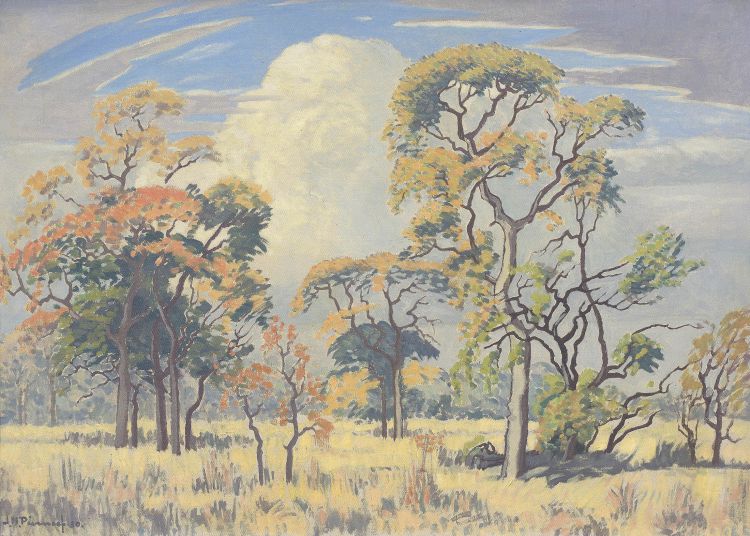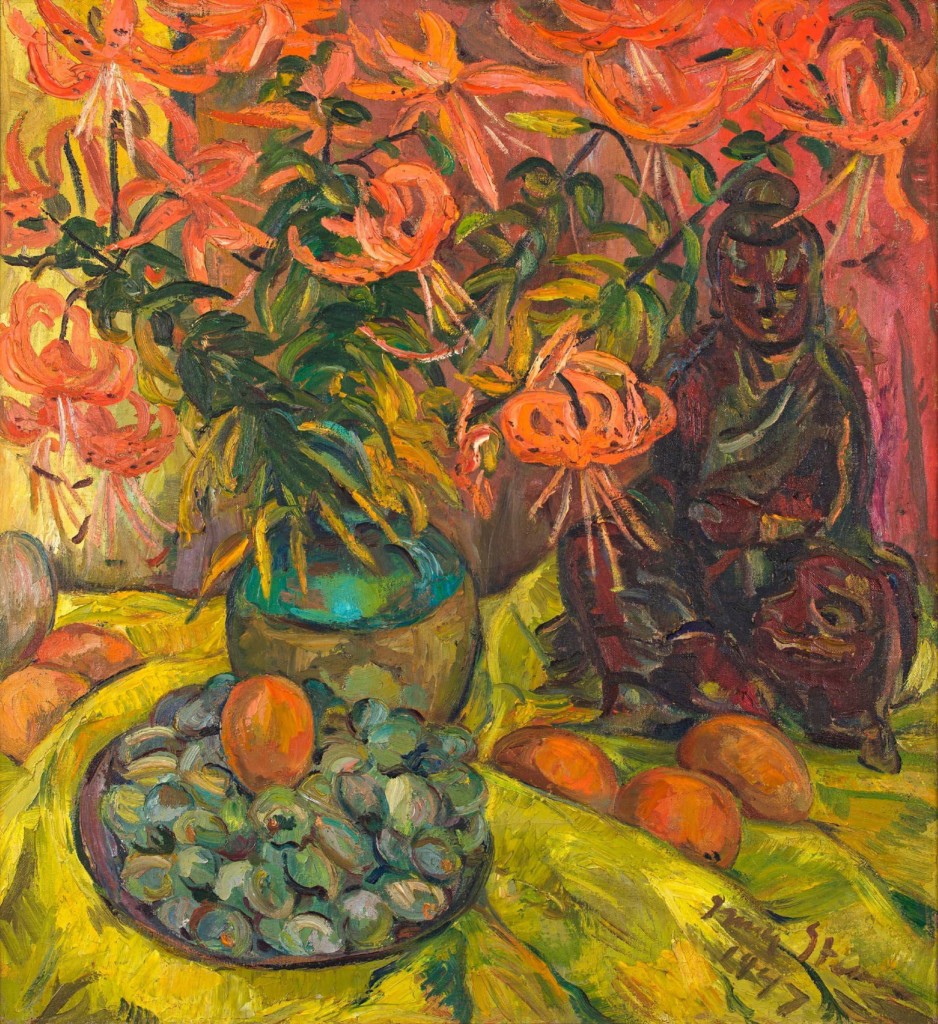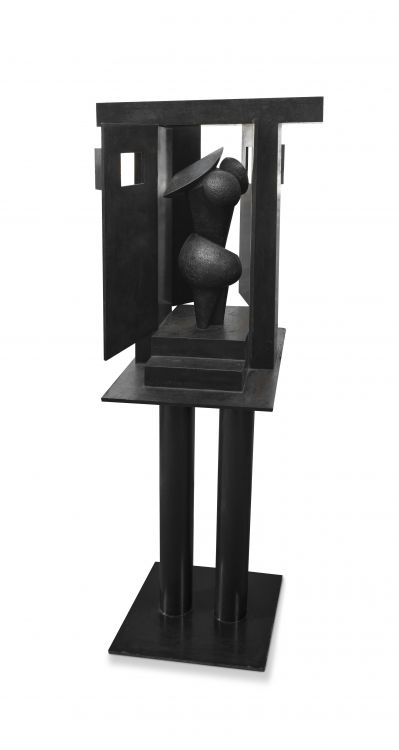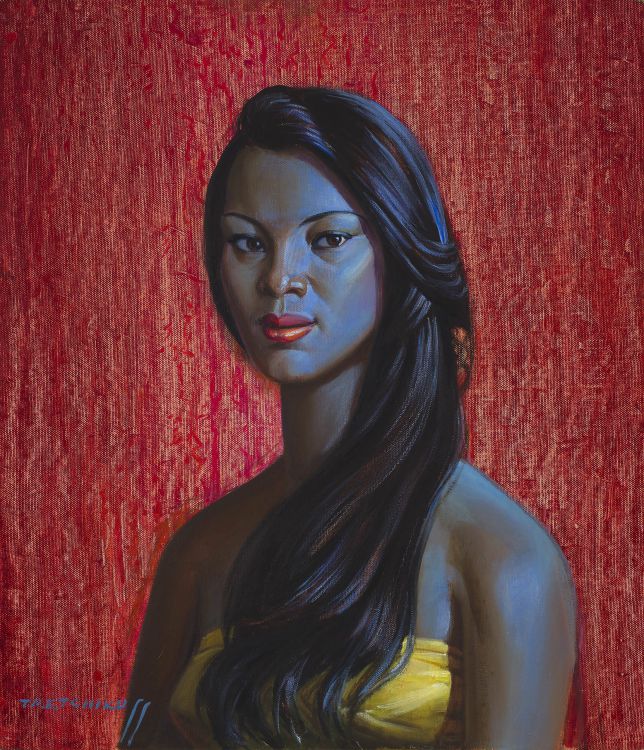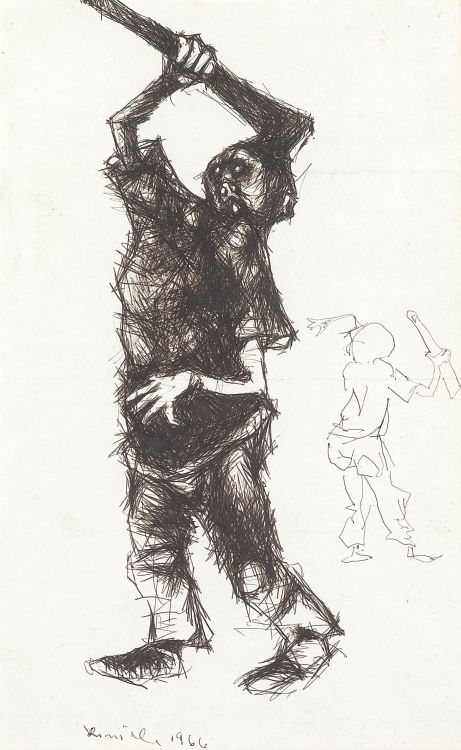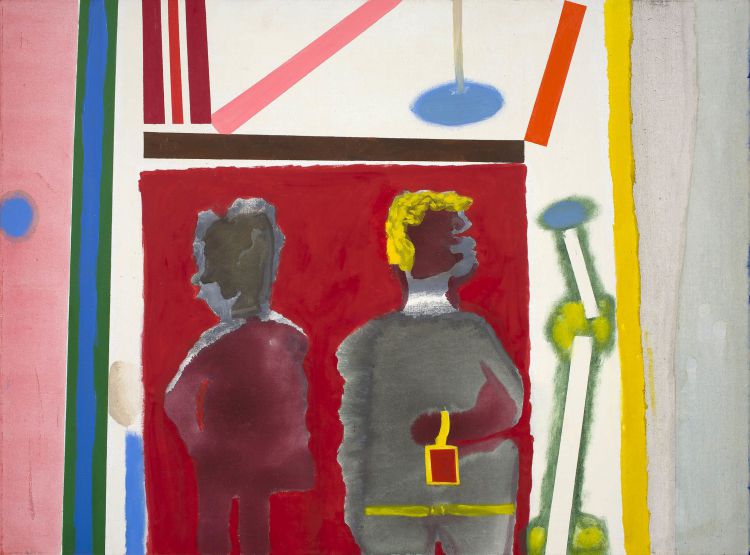Throughout the past decade international interest in South African art – both modern and contemporary – has grown immensely. South Africa’s leading fine art auction house Strauss & Co has long been the go-to place for local and international collectors looking to grow collections by the biggest South African artists. On May 11 Strauss & Co host their first-ever live online with the help of the world’s top online auction platform Invaluable.com.
This latest auction focuses on 19th century, Modern, Post-War and Contemporary Art. Complementing the live online auction, there is also a series of free ‘virtual art talks’ every day at 16:00 on Zoom with Strauss & Co’s resident art experts discussing the different artists and works featured in the auction.
Find out more about the auction and how to bid and what’s coming up in the virtual art talk series at straussart.co.za.
Ahead of this landmark auction, here is a look at ten iconic 20th Century South African artists who every art lover should know.
JH Pierneef
Jacobus Hendrik Pierneef (1886-1957) was born in Pretoria to Dutch-Boer parents in 1886. During the Anglo-Boer War the family briefly returned to live in the Netherlands although it was not until 1925 that the young artist made his first professional trip to Europe. Pierneef visited France, Germany, Belgium and the Netherlands and was inspired by the burgeoning neo-impressionist and modernist movements and their predecessor Art Nouveau, that were then sweeping the continent.
Previously celebrated for his monumental impressionistic visions of the South African landscape, Pierneef brought back with him to South Africa a fresh new style which he told friends would “deliver a heavy blow on the Pretoria frontier” and “shock many an art connoisseur”.
This dramatic new avant-garde style, filled with geometric shapes and symbolist tones, is now much admired but failed to woo the more traditional Pretoria art buying classes of the time. In 1929 Pierneef was commissioned to paint 32 panels for the interior of the then-new Johannesburg Railway Station (now Park Station), a task he completed by 1932 (the original panels are now on display at the Rupert Museum in Stellenbosch).
The works which Pierneef produced between the late 1920s and early 1930s following his return from Europe are among his most highly regarded and in recent years some have sold at auction for upwards of R6 million (around 500,000 Euros).
Irma Stern
Arguably South Africa’s most famous female artist, Irma Stern (1894-1966) was a prolific painter of both still lifes and portraits and one of this country’s most influential expressionists.
Born to German-Jewish parents in the small town of Schweizer-Reneke in the now North West Province, from a young age Stern travelled with her family between South Africa and Germany, an experience which left her with a life-long love of travel. In the mid-1910s Irma Stern travelled to Germany to study art at the Weimar Academy where she became heavily influenced by the burgeoning expressionist scene. However, when she returned to South Africa, the South African art world was dismissive of her expressionist talents which were at odds with the conservative fashions of the time, with some critics even going as far as to proclaim “Art of Miss Irma Stern – Ugliness as a cult”.
Undeterred, Stern continued to travel extensively across Africa in search of colourful subject matter that was little seen on South African canvases at the time, visiting the Congo, Central Africa, Senegal and Zanzibar as well as Swaziland, Namaqualand and Pondoland.
Particularly fond of portraiture Irma Stern sought out enigmatic African subjects who when presented at the galleries of 1920s Cape Town represented an ‘an absolute shock to the establishment’ who couldn’t accept her striking expressionist visions of ‘sensual brown figures lying under trees’ and regarded her art as ‘immoral’.
Besides her portraits, Stern is most celebrated for her luscious floral still life paintings which she used as a space to refine her masterful use of colour and dynamic detailing of objects. Dazzlingly vibrant bouquets of flowers such as ponsiettas, delphiums and dahlias as well as fruits feature prominently in these extraordinary paintings which burst with a resplendent array of colours.
Always more widely appreciated in Europe than in her native South Africa, it was only towards the end of her career that Stern finally managed to gain the widespread acclaim and praise of the South African art world. In 1971 the Irma Stern Museum was established in Cape Town.
Alexis Preller
Hailed as one of Africa’s leading modern artists of the 20th Century, Alexis Preller‘s (1911-1975) most significant works were for many years ‘lost’, represented only by black and white photographs taken at the artist’s studio and were recently ‘rediscovered’ in the homes of private collectors and friends of the artist. An exciting discovery which helped further launch Preller into the global art world spotlight.
Preller’s influences were many, from his service in the ambulance corps during World War II and time spent as a POW to his interest in the animal world, mythology, African art, and particularly in masks, and his travels in Europe, North Africa and the Indian Ocean islands.
A serious and dedicated man, Preller worked with great intensity and his work is complex, and many-layered. Something that makes the experience of viewing the diverse pieces incredibly compelling. You want to look, and look some more. There are always mysterious elements, dreamlike landscapes or figures that are intriguing and somewhat mystical.
Gerard Sekoto
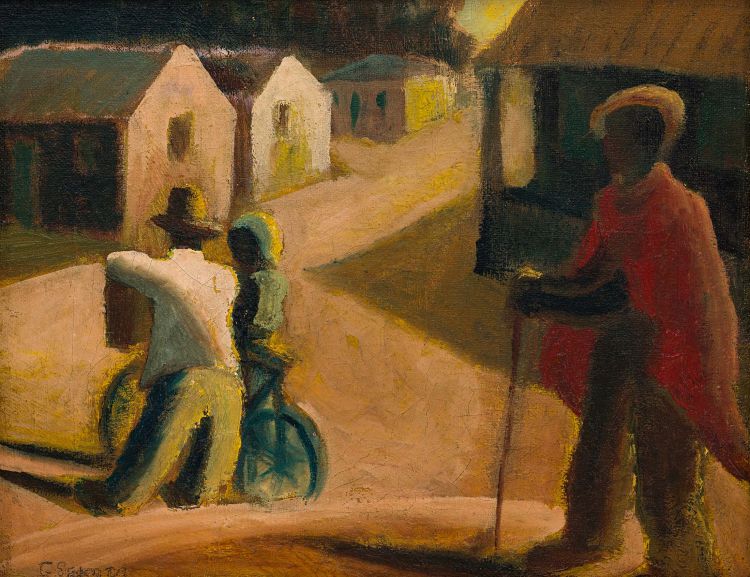
Gerard Sekoto (1913-1993) is celebrated as a pioneer of urban black art in Africa. In particular, Sekoto’s works present a glimpse of everyday life for black South Africans living in racially-mixed suburbs liked District Six and Sophiatown in the years just before the apartheid government’s enforced separation through the Group Area’s Act in 1950s.
Born in 1913 in Middelburg in Mpumalanga (then known as the Eastern Transvaal), Sekoto was raised in a missionary family and began creating art while a teenager before going on to graduate from a teacher training college. He spent four brief years working as a teacher before making the brave decision to move to Joburg to pursue a career as an artist.
It was in Sophiatown in Johannesburg that Sekoto’s career took off. He began experimenting with a graphic treatment of the landscape, juxtaposing bold colours and an expressionist style to vividly portray the street life of this diverse and rapidly changing neighbourhood.
In 1942 Sekoto moved to the colourful District Six neighbourhood in Cape Town and continued to record the vibrancy of black urban life in his canvases, before returning north again in 1945 to spend his final years in South Africa in the rundown black township of Eastwood outside Pretoria before then making the decision to emigrate to Paris in 1947.
His final years spent in South Africa before emigrating to Paris, are regarded as the peak of his career. His colour palette expanded to incorporate vibrant shades and he sharpened his skill for capturing the mood and movement of ordinary scenes.
Sekoto’s first years in Paris proved devastating as he battled the cold, financial hardship, a lack of recognition and a cultural shock compounded by his poor grasp of French. Sekoto was forced to take up work playing jazz and singing ‘Negro spirituals’ at the Jacob’s Ladder jazz club, eventually forming a successful music career that supported his artistic endeavours.
He spent the rest of his life in Paris and died in a home outside the city in 1993, having only finally received the recognition that had long eluded him back home as a pioneering black artist. In 1989 he was honored with a retrospective exhibition at Johannesburg Art Gallery and a posthumous honorary doctorate degree from the University of Witwatersrand.
Walter Battiss
Instantly recognisable, Walter Battiss (1906-1982) is one of South Africa’s most prolific artists and it is his imagination, whimsy and sheer breadth of talent across a wide range of media that he is best remembered for.
Inspired particularly by ancient African rock art as well as his travels through the Indian ocean and south Pacific, throughout his career Battiss produced prints, paintings, performance art, watercolours, conceptual works and pop art images that have become iconic. A very versatile artist who, like his friend and contemporary Picasso, continually liked to innovate and experiment with different styles, Battiss’s inventiveness and imagination have made him one of South Africa’s most popular artists.
Probably his most famous ‘invention’ is that of Fook Island, an “island of the imagination” for which he created a map, imaginary people, plants, animals, a history as well as a set of postage stamps, currency, passports, driver’s licenses and even a ‘Fookian’ language complete with its own alphabet.
Working in a time of intense censorship in South Africa, Battiss arguably never quite gained the level of international acclaim that he deserved, especially given the pariah status of the South African state (Battiss died in 1982). Some of his more radical moments of protest art are also often forgotten, such as the huge collection of erotica which he created in protest against puritanical apartheid censorship.
Edoardo Villa
One of South Africa’s most influential sculptors, Edoardo Villa (1915-2011) was a prolific artist who created more than 1,000 sculptures during his career and profoundly influenced the way that modern, abstract sculpture is understood and celebrated today in South Africa.
Born in Italy in 1915, Edoardo Villa was an art student in Milan before he was conscripted to join the Italian army and sent to the battles of World War II. In 1942 he came to South Africa as one of some 70,000 Italian prisoners of war who were incarcerated at the Zonderwater POW camp near Pretoria, a camp which became famous for its humane treatment of POWs who received literacy education and were allowed access to musical instruments and artistic materials. After the end of the war Villa chose to remain in South Africa and pursue a career as an artist.
Inspired by cubism, constructivism and stylised abstraction, Villa began to experiment with welding pieces of metal together in the 1950s (as opposed to simply casting in moulds), a technique that would define much of his work during his long career.
Throughout the 1950s he also taught at the Polly Art Centre in Johannesburg, one of the few institutions in South Africa where black artists could pursue a career and stage exhibitions. In 1961 he became a member of the Amadlozi (ancestors) group of artists (which included other major modernists such as Sydney Kumalo and Cecil Skotnes), known for their conscious appropriation of African sculptural traditions, incorporating African geometric forms into his increasingly abstract representations.
Living in Johannesburg, the grid-like rectangular shapes of the urban city landscape also found their way into the language of Villa’s sculptures, while Villa’s experience of imprisonment and his humanist concern for the ever-tightening stranglehold that the apartheid state held on South African society was a constant influence, particularly during the increasingly repressive and violent 1970s and 1980s when he produced his Prisoner series of distinctive caged anthropomorphic figures.
Vladimir Tretchikoff
Vladimir Tretchikoff (1913-2006) is best known for his portrait Chinese Girl (also known as The Green Lady), one of the most popular art prints of all time. Described by some of his more surly critics as ‘the Mona Lisa of kitsch’ The Green Lady was sold at auction in London for almost $3.5 million (approximately R15 million) in 2013.
Tretchikoff was born in Russia on the eve of the Russian revolution, from where his family soon fled, settling in China. From an early age Tretchikoff embarked on a career in art, working at first as a theatre set painter. During World War II he was employed as a propaganda painter for the British in Singapore. While being evacuated from the Far East to South Africa during the war he was shipwrecked and ended up spending several months in Indonesia as a Prisoner of War before eventually reuniting with his wife in South Africa.
The couple settled in Cape Town and Tretchikoff quickly found fame and fortune as an artist with audiences particularly captivated by his portraits. Numerous international tours followed in the USA, Canada and London where crowds turned up in their thousands to view his works.
While many critics dismissed Tretchikoff’s work as too kitsch or too popular, other critics have defended his popularity and argued that he “achieved everything that Andy Warhol stated he wanted to do but could never achieve because of his coolness” (Wayne Hemingway, Just Above The Mantelpiece). Andy Warhol for his part reportedly took the view “It has to be good, if it were bad, so many people wouldn’t like it.”
Dumile Feni
Few South African artists can claim a more tragic life and immense talent that Dumile Feni (1942-1991). Born Zwelidumile Geelboi Mgxaji Mslaba “Dumile” Feni in 1942 in Worcester, Western Cape, Feni’s mother died when he was only five years old. He went to live with relatives in Cape Town until the age of eleven when he began working for his father as a trader and preacher.
As a child Feni harbored a passion for carving and drawing and in the early 1950s, following the death of his father, he moved to Johannesburg to begin work as an apprentice at a pottery and sculpture foundry. In 1963 after spending three months recovering from tuberculosis at a Soweto hospital Feni was introduced to the Polly Street Art Centre by fellow artists he met at the hospital. Here he made friends with the white artist Bill Ainslie who would become his life long friend and mentor.
Through the 1960s Feni’s distinctive and emotionally fraught work began to gain serious international recognition, being displayed at the Sao Paolo Biennale and at exhibitions in Antwerp and London. However, during this period the apartheid state’s scrutiny of his work and life also grew. The regime viewed Feni as a political dissident and an ‘enemy of the state’ and denied him his ‘pass’ to remain in Johannesburg. Forced with a choice between jail, a return to the Cape ‘homelands’ or life in exile, Feni chose exile.
In 1968 Feni left for London, falling in with a crowd of fellow exiled South African intellectuals before eventually moving to the USA in the late 1970s where he spent the rest of his life.
Despite being widely exhibited and praised by critics, Feni’s life in exile was characterised by poverty. He often struggled to find a place to live, reportedly spending time sleeping in London tube stations or living in bleak New York basements surrounded by the beautiful clay models which he could not afford to cast in bronze. In 1991, just before he was due to finally return from exile and move back to Johannesburg Dumile died from a heart attack.
Dumile’s powerful works, mostly sculptures and works on paper, depict anguished figures, often contorted and distorted, filled with powerful, visceral emotions, depicting humanity trapped in anguish and a world tied up in conflict and competing layers of shadow and light.
Robert Hodgins
Robert Hodgins (1920 – 2010) was born in London and immigrated to South Africa in 1938. He spent much of his career working as a journalist and critic for Newscheck magazine and teaching at Wits University. It was only in the 1980s that he retired to become a full-time artist, working and exhibiting intensely right up until his death.
In the 1980s, Hodgins was part of a significant group of South African artists who began developing unique styles that made distinctive expressionist anti-apartheid statements. Hodgins’ fascination with portraying the paradoxes of a world where extremes of beauty and horror co-exist can be seen in his print, oil and acrylic works, filled with images of malevolent businessmen, power-hungry tyrants, sensual men and women and prisoners.
As Goodman Gallery described in a 2000 Hodgins exhibition his works bristle with the energy and the pleasures of life: “There are paintings that stem from memory and from a sombre look at the human condition. Paintings about the construction and confusion of contemporary urban life, but also paintings about the pleasures of being alive, pleasures that crowd in upon the pessimism everywhere – that crowd in and refuse to be ignored”.
Peter Clarke
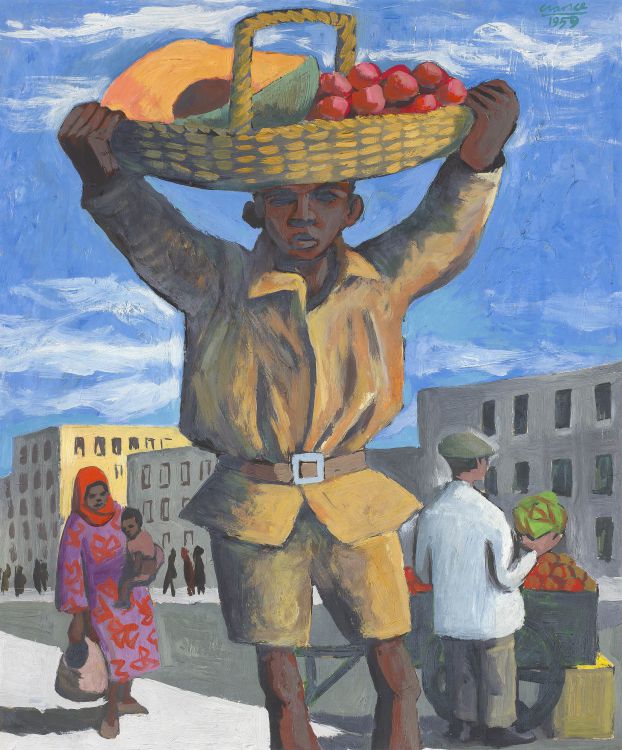
Peter Clarke (1929-2014) was a writer, poet and painter born in Simonstown near Cape Town. Clarke grew up by the sea and early in his life spent time working on the docks. In 1972 he was forced to move to the township of Ocean View under the Group Areas Act and both images of the coast and seaside villages, as well every day scenes of township life under apartheid, dominate Clarke’s distinctive ouevre.
With the help of friend and poet James Matthews, Clarke held his first solo exhibition in 1957 and later remarked that; “Before my exhibition, I was just another coloured man. Our people took it for granted that only whites could do such things. Now they are becoming aware of the fact that we can do these things too; that we are human beings.”
Clarke is best known for his gorgeous graphic prints, particularly woodcuts, and paintings although he also worked with collage using glass, sand and found objects to bring texture to his colourful works.
While Clarke had a more than six-decade career as an artist, like all ‘non-white’ artists working in South Africa during apartheid he never achieved the exposure and acclaim that he deserved during his lifetime, only becoming celebrated in international exhibitions and highly sought-after by collectors in the recent years.
A 2014 exhibition of his work in the USA described Clarke as a “quiet chronicler” of South Africa’s social and political history and it is this subtle and distinct depiction of 20th Century South African life that makes Clarke’s works so compelling, particularly to contemporary viewers.
If you haven’t already signed up for our weekly What’s On In Joburg newsletter showcasing the best cultural events of the Joburg week – sign up here.
